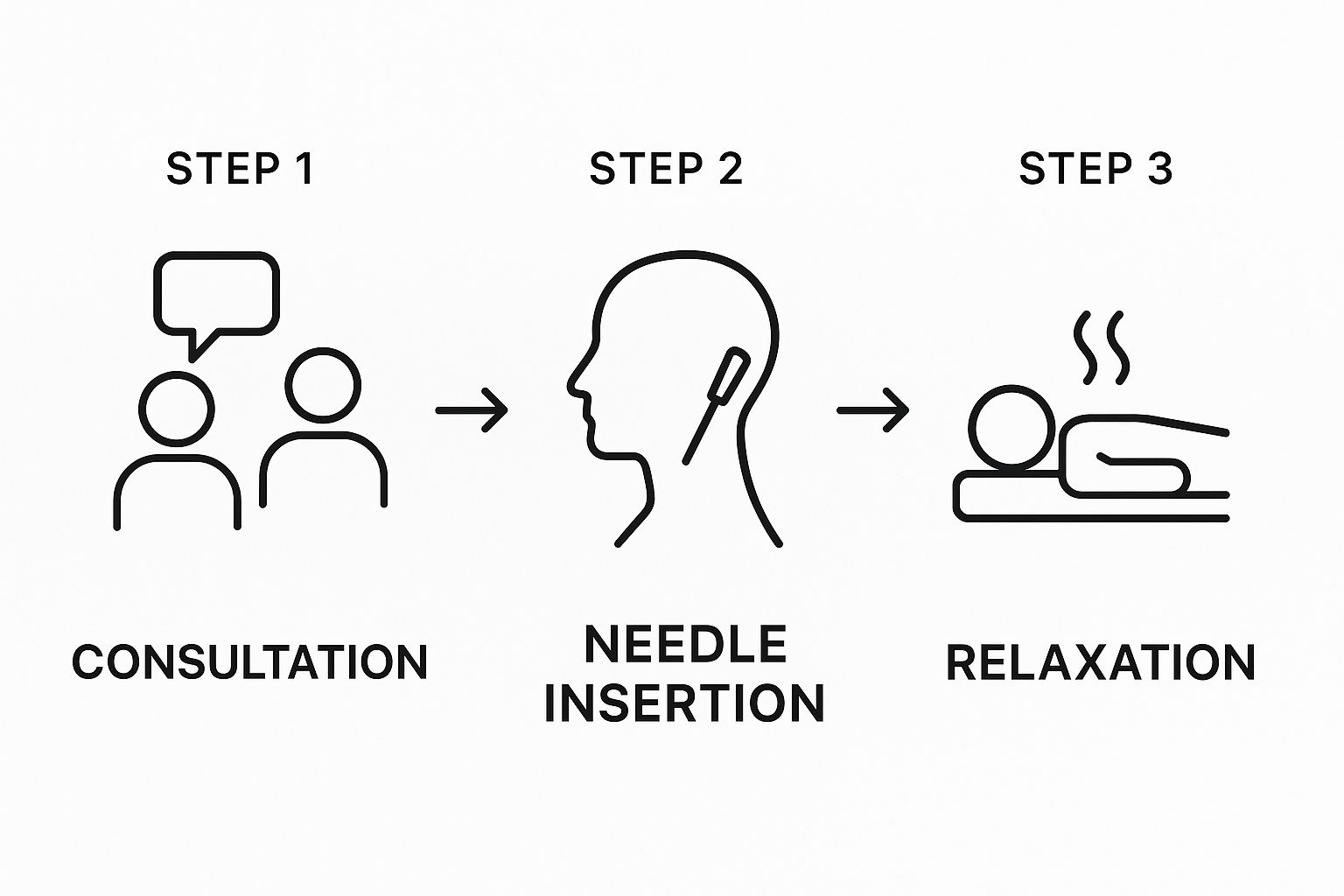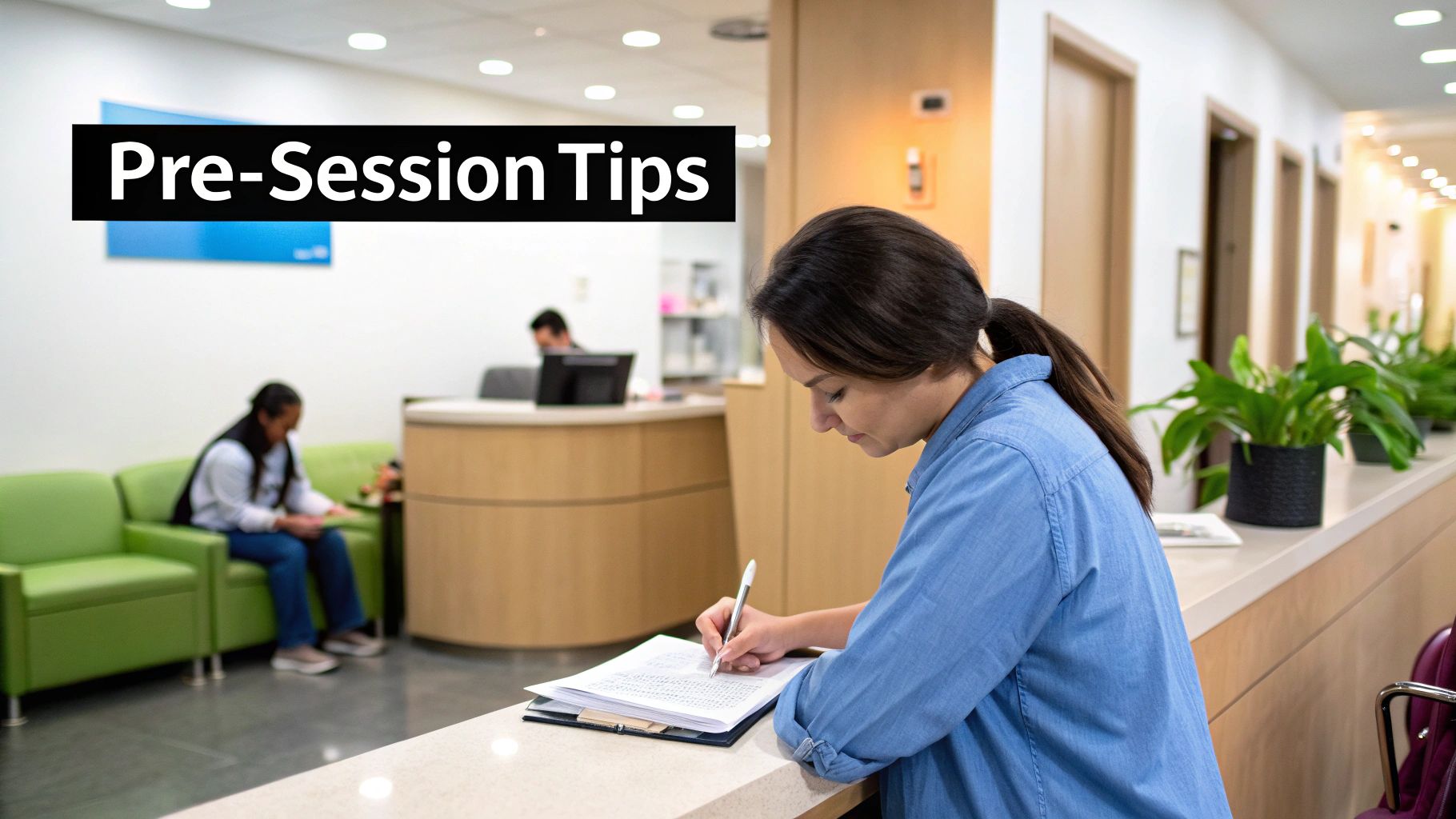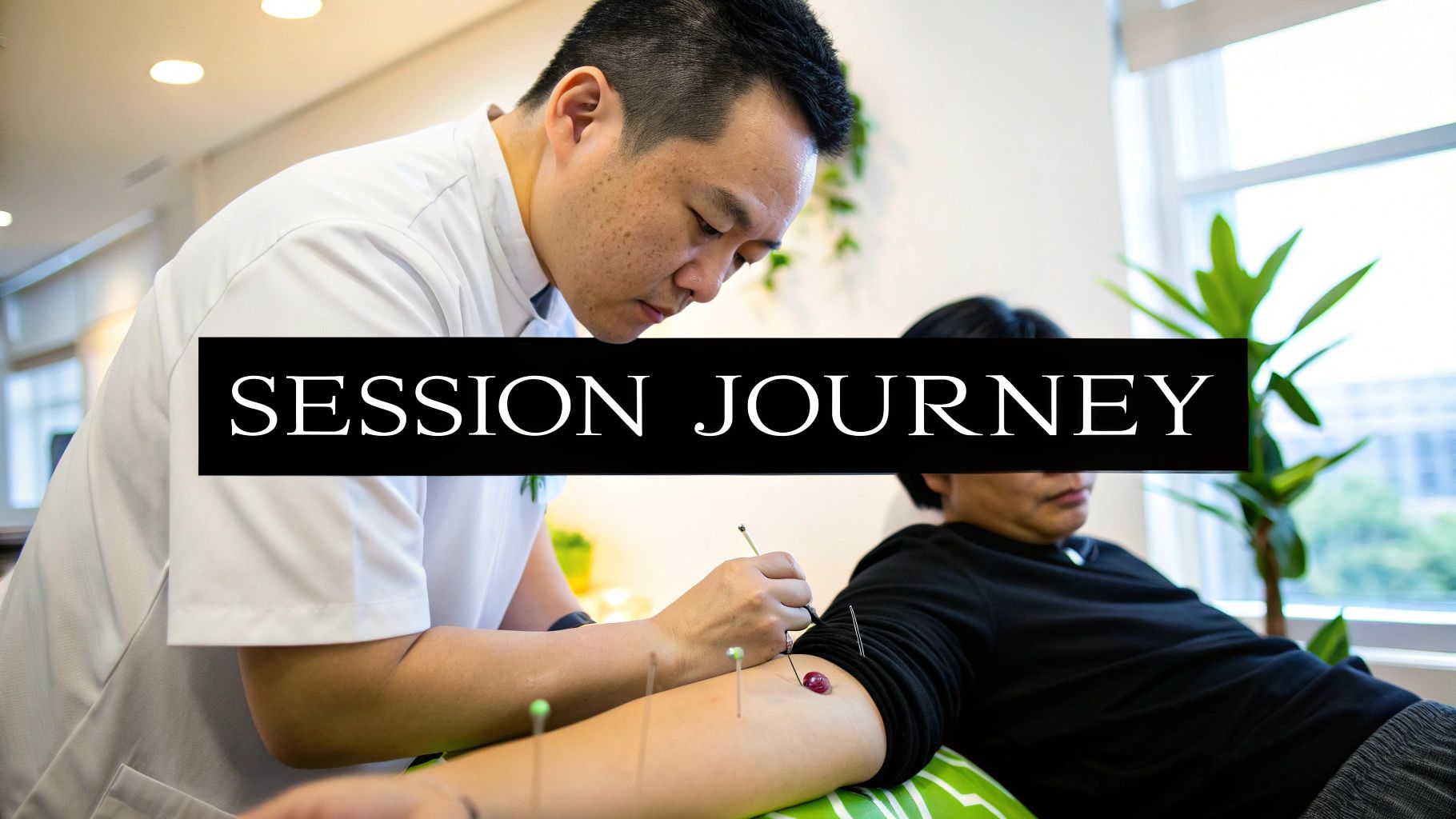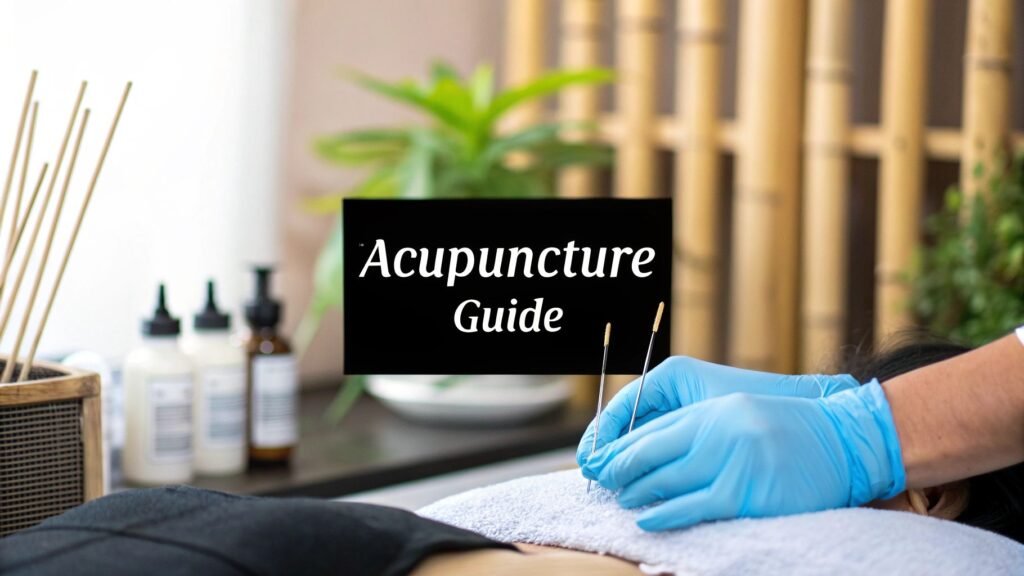So, you're curious about what your first acupuncture session will actually be like. It's a common question, and I'm here to walk you through it. Think of it as a four-part process: we start with a good conversation, then move to the needle placement, followed by a period of quiet rest, and finish up with some simple aftercare tips to help you get the most out of your treatment.
Your First Acupuncture Session Unpacked
Stepping into an acupuncturist's office for the first time can feel a little intimidating, but I promise the whole process is designed to be comfortable and straightforward. Honestly, it's no wonder so many people are turning to acupuncture. The market has seen a compound annual growth rate of 13.7% since 2019, which tells you a lot about the growing trust in effective, non-pharmaceutical health solutions. If you're interested in the data behind this trend, Persistence Market Research offers some great insights. This growth just proves that people everywhere are finding real value in this time-tested practice.
Your first appointment is more than just a treatment; it's the start of a therapeutic partnership. We build the entire experience around understanding and addressing your specific health goals in a calm, supportive space. Every step has a clear purpose, all working together to help rebalance your body and kickstart its natural healing abilities.
To give you a clearer picture of your first visit, I've broken down the typical stages of the appointment in the table below. It outlines what's happening at each point and roughly how long it takes.
Anatomy of Your First Acupuncture Session
| Appointment Stage | What Happens | Typical Duration |
|---|---|---|
| Initial Consultation & Intake | We'll sit down and talk. You'll share your health history, concerns, and goals. The acupuncturist will also likely check your pulse and look at your tongue to get a full picture of your body's energetic state. | 15-30 minutes |
| Treatment & Needle Placement | You'll get comfortable on the treatment table. The acupuncturist will then gently insert the sterile, hair-thin needles into specific points on your body based on your individual diagnosis. | 5-10 minutes |
| Rest & Relaxation | This is your time to relax. Once the needles are in place, you'll rest quietly while they do their work. Many people drift into a deeply relaxed, meditative state or even take a light nap. | 20-30 minutes |
| Needle Removal & Aftercare | The acupuncturist will gently remove the needles (it's quick and painless). Afterward, you'll discuss a treatment plan and get recommendations for what to do post-session to support the healing process. | 5-10 minutes |
As you can see, the whole session is structured to be a smooth, logical progression from one step to the next. It's all about making you feel comfortable and cared for.
The Flow of Your Treatment
The actual treatment portion of your visit flows naturally from understanding your needs to taking action, and finally, to letting your body rest and integrate the work.
Your first visit is a collaborative process. We're not just chasing symptoms; we're working together to uncover and address the root cause of your health concerns to build a foundation for lasting wellness.
This simple image gives you a great visual of that three-part flow during the core treatment phase.

As the diagram shows, we move from dialogue to action to rest. It's a seamless experience designed to make sure you're informed and at ease every step of the way. Now, let's dive a little deeper into what each part of the appointment really feels like.
2. Preparing for Your Appointment and Initial Consultation

A great acupuncture experience starts well before you’re on the treatment table. A little preparation goes a long way, helping you feel relaxed and setting the stage for a more effective session.
First, think about what you’ll wear. Your best bet is loose, comfortable clothing that can be easily adjusted. Many of the most-used acupuncture points are on your arms and lower legs, so baggy pants or a loose top make it easy for your practitioner to access these spots without you having to fully disrobe.
It's also a good idea to eat a light meal or snack about one or two hours before you arrive. Coming in on an empty stomach can sometimes leave you feeling a bit dizzy during treatment. On the flip side, you don't want to be uncomfortably full, so a small, balanced meal is just right.
The Comprehensive Health Discussion
Your first appointment will almost always be the longest, and that's because the initial consultation is incredibly thorough. This isn't just a quick Q&A about your main complaint; it's a deep dive into your entire health history. Think of your acupuncturist as a health detective, looking for clues to piece together the full story of your well-being.
They'll ask you questions that might seem completely unrelated to why you came in. Be ready to talk about your sleep habits, your digestion, your daily energy fluctuations, and even your emotional state. This big-picture approach is a core principle of Traditional Chinese Medicine (TCM).
This holistic conversation is all about identifying underlying patterns of imbalance. In TCM, your symptoms are like the leaves on a tree. The real goal is to find and treat the root of the problem, not just trim the leaves.
This is why your treatment is designed specifically for you. Two people might come in for headaches, but based on their unique internal landscape, they could receive completely different acupuncture treatments.
Building Your Personalized Treatment Map
From this conversation and other diagnostic techniques—like looking at your tongue and feeling the quality of your pulse at your wrist—your acupuncturist will form a TCM diagnosis. This diagnosis helps them understand where your body's energy, or Qi (pronounced "chee"), is stuck, weak, or out of sync.
This crucial information helps your practitioner map out your treatment. Specifically, it determines:
- Which acupuncture points to use: Every person gets a unique combination of points selected to restore their specific imbalance.
- What other therapies might help: They might recommend adding cupping, gua sha, or herbal formulas to enhance the treatment.
- A recommended treatment schedule: You'll get a clear plan for how often you should come in to get the best and most lasting results.
This foundational step ensures your acupuncture journey is anything but one-size-fits-all. By getting to the root of the issue, your practitioner can help guide your body back to its natural state of balance, right from the very first session.
Let's Talk About the Needles (and What You’ll Actually Feel)

Alright, let's get right to the elephant in the room: the needles. For most newcomers, this is the biggest hang-up, and understandably so. When we hear "needle," our minds jump to getting a shot or having blood drawn—but I promise you, this is a completely different experience.
Acupuncture needles are nothing like the hollow, thick hypodermic needles you're picturing. They are solid, sterile, single-use, and incredibly fine. To give you some perspective, many are as thin as a single strand of human hair. Their job isn't to inject anything, but to slide gently between tissues with minimal fuss. Most people barely feel a thing when they go in.
This gentle approach is a huge reason why acupuncture has become a go-to for pain management. It's a field that's growing rapidly, expected to become a $12.65 billion market by 2025 as more people look for effective, non-pharmaceutical options. You can dive deeper into this trend in the acupuncture market report.
The "Arrival of Qi"—The Feeling of Deqi
Instead of a sharp poke, the sensation we're actually looking for is something called Deqi (pronounced "duh-chee"). This is a cornerstone of Traditional Chinese Medicine and, from a practitioner's standpoint, it’s the signal that we’ve made a connection and the treatment is underway. It’s the feeling of your body’s energy, or Qi, being engaged by the needle.
Deqi is often translated as the "arrival of Qi." It’s not pain; it’s a therapeutic sensation. Think of it as your body saying, "Okay, I feel that," and starting a conversation with the needle to begin the healing process.
This feeling is a good thing—it means we're on the right track.
So, What Does Deqi Actually Feel Like?
The experience of Deqi is unique to everyone and can even feel different from one point to the next on your own body. It’s a clear sign that the treatment is actively stimulating your body’s natural ability to heal itself.
Here are a few ways patients typically describe the sensation:
- A dull, heavy ache: A comforting, deep pressure that settles around the needle.
- A spreading warmth or coolness: A subtle shift in temperature that radiates from the point.
- A slight tingle or buzz: Almost like a very mild, pleasant electric hum.
- A radiating feeling: A sensation that seems to travel along a distinct pathway from the needle, often tracing the body's meridian lines.
These sensations are usually brief, lasting just a moment after I’ve set the needle. Once they fade, you’re simply left to rest peacefully. Knowing what to expect from Deqi can really shift your mindset from apprehension to a sense of curious participation in your own healing. It's the confirmation that your body is already starting to find its balance again.
The Treatment Itself and the Rest Period
Once all the needles are in place, your part is surprisingly simple: just relax. We design our treatment rooms to be sanctuaries of calm. Think soft, dim lighting, a comfortable treatment table, and maybe the gentle sound of soothing music or a white noise machine humming quietly in the background.
With the needles set, you’ll be left to rest for about 20 to 30 minutes. While it might feel like you’re not doing much, this quiet phase is where the real magic happens. It’s an active therapeutic state where your body starts responding to the subtle signals from the needles.
What Is Happening Inside Your Body
During this rest period, a whole cascade of beneficial things is happening under the surface. From a modern biomedical viewpoint, the needles are stimulating nerve pathways. This prompts your brain to release its own natural painkillers—like endorphins—along with other powerful neurochemicals that can lift your mood and dial down stress.
This process also helps shift your nervous system out of a constant “fight-or-flight” state and into a much-needed “rest-and-digest” mode. It's no wonder so many people feel a profound sense of calm and often drift into a light, refreshing nap.
This quiet interval is not just downtime; it is the core of the treatment. It's when your body's internal pharmacy gets to work, rebalancing systems and initiating the healing process from within.
From the perspective of Traditional Chinese Medicine (TCM), this is when your Qi—your body's vital energy—is guided back into harmony. The needles act like tiny traffic directors, clearing up blockages and encouraging energy to flow smoothly through the meridians. This rebalancing is the very foundation of good health in TCM. The deep relaxation you feel is a direct sign that this energetic harmony is being restored. Many people find this is especially effective for conditions tied to being chronically overstimulated, and you can learn more about how acupuncture can address chronic fatigue to see this connection in action.
The Gentle Removal of Needles
When your rest time is up, your acupuncturist will come back in to gently take out the needles. This part is quick and completely painless. They slide out just as easily as they went in—most people barely notice.
We safely dispose of all single-use needles and will give the points a quick check to make sure everything feels fine. After the last needle is out, we’ll have you sit up slowly. Many people describe feeling a unique combination of deeply relaxed yet clear-headed, a state we affectionately call "acu-bliss." This peaceful, energized feeling is a great sign that your body is responding beautifully to the treatment.
Aftercare and What to Feel Post-Treatment

The work doesn't stop once the last needle is removed. In fact, the hours following your appointment are a critical time for your body to process the treatment and continue healing. Think of it like a freshly tilled garden—you've done the hard work, and now you need to give it the right conditions to let everything settle and thrive.
Your practitioner will provide personalized advice, but a few general principles can help you make the most of your session. The main takeaway? Be gentle with yourself. Your body has just undergone a significant energetic shift, and giving it the right support helps lock in those positive changes.
Your Post-Treatment Care Guide
To really amplify the effects of your acupuncture, weaving these simple actions into the rest of your day can make a big difference. This isn’t a rigid list of rules, but more of a gentle guide to honor the therapeutic work that's just started.
- Stay Hydrated: Sip on plenty of room-temperature water. Good hydration is key to helping your system flush out any metabolic waste released during the treatment.
- Avoid Strenuous Activity: This is not the day to hit the gym for a high-intensity workout or lift heavy furniture. A gentle walk is perfectly fine, but you want to conserve the energy your body is now directing toward healing.
- Eat a Nourishing Meal: Opt for a healthy meal that's easy to digest. Your body will thank you for simple, wholesome fuel as it works to rebalance itself.
- Take It Easy: If you can, steer clear of high-stress situations. A warm bath, a good book, or some calming music can extend that state of deep relaxation you felt on the table.
The sensations you feel after acupuncture are a direct conversation your body is having with you. Whether you feel profoundly relaxed or gently energized, these are all positive signs that your system is actively recalibrating and moving toward a state of better balance.
Common Sensations After Acupuncture
One of the first things people ask is what to expect from acupuncture once they get off the table. The truth is, everyone's experience is unique, but the feedback is almost always overwhelmingly positive.
Many people report feeling a deep sense of calm and well-being, a sensation we often call "acu-bliss." This peaceful feeling can linger for hours, sometimes even days. On the other hand, you might feel a clean surge of energy and mental clarity, as if a stubborn fog has finally lifted. It’s also very common to notice that your baseline stress levels are much lower, which is why exploring acupuncture for stress management is a great next step for many.
Once in a while, you might notice very minor side effects, like feeling a bit drowsy or seeing a tiny bruise at a needle site. Don't worry—these reactions are completely normal, temporary, and just part of the body's natural response. Listening to your body and noting these feelings gives both you and your practitioner valuable insight into your healing journey.
So, When Will I Feel Better? Setting Expectations for Your Treatment Plan
One of the most common questions I hear is, "How long will this take?" It's a fair question, but the answer isn't always simple. Think of acupuncture less like a magic bullet and more like starting a new fitness routine. You wouldn't expect to have six-pack abs after one trip to the gym, and similarly, acupuncture works by building momentum in your body over time.
While some people feel a noticeable shift after their very first session—maybe a little less pain or a sense of calm—the real, lasting changes for chronic issues come from the cumulative effect of consistent treatments.
Committing to an initial series of appointments is truly the key to giving your body the best chance to heal.
- Starting the Journey: Most practitioners recommend coming in once or twice a week at the beginning. This frequency helps build a therapeutic response and gets the healing process into a steady rhythm.
- Finding Your Groove: As you start to feel better and your symptoms improve, we can spread those visits out—first to every other week, and eventually to monthly "tune-up" appointments to maintain your progress.
- The Typical Timeline: For many long-standing conditions like chronic pain, a full course of treatment might involve somewhere between 8 to 12 sessions. Of course, this is just a general guide; your path will be unique to you.
Your acupuncturist acts as your guide, constantly monitoring how you're responding. We'll check in on your symptoms at each visit, and we might adjust the points we use based on your feedback and what we observe. Your treatment plan isn't set in stone; it's a living document that evolves with you.
"Acupuncture’s strength lies in its ability to support steady healing,” says Dr. Tsai. He often emphasizes the value of patience and persistence with his patients.
How We Track Your Progress and Adapt the Plan
How do we know it's working? It’s a mix of art and science. We use several methods to gauge your progress and fine-tune your treatments.
This often involves straightforward tools like pain scales or patient check-in forms. We also rely on traditional diagnostic techniques, like observing your tongue and feeling your pulse, which give us a deeper look into your body's internal balance.
Most importantly, we'll talk. Open and honest conversation is crucial. Did you have a major spike in stress at work? Did you change your diet? These details help us adjust your treatment to match what’s happening in your life right now. It's this partnership that truly makes the treatment effective.
When to Expect Real, Lasting Change
You'll likely notice small, positive signs within the first one to three treatments—perhaps a bit more energy, better sleep, or a subtle easing of your main complaint.
However, for lasting improvement with chronic conditions, you’ll typically start to see significant, more stable results after about 6 to 8 sessions.
This isn't just anecdotal. The effectiveness of acupuncture for chronic issues is a major reason for its growing acceptance worldwide. In fact, due to the rising number of people dealing with chronic pain, the acupuncture market in North America alone is projected to reach $15.5 billion by 2025. You can dig deeper into the numbers with these acupuncture market forecasts on Maximize Market Research.
Key Insight
Try to view each session as a single step on a longer journey. When you see each treatment as a building block, it helps set realistic expectations and makes the entire process feel more manageable and empowering.
Staying consistent and keeping the lines of communication open with your practitioner will turn your treatment plan into a reliable roadmap toward better health. Remember, everyone's body responds differently. The best thing you can do is pay attention to your own experience, share it with your acupuncturist, and trust the process. This steady commitment is what so often leads to profound, long-term benefits.
Your Acupuncture Questions, Answered
It’s completely normal to still have a few questions swirling around, even after learning about the process. Getting straight answers to common concerns is often the final step before feeling truly ready and confident about your first appointment. Let's tackle some of the most frequent questions I hear from new patients.
Does Acupuncture Actually Hurt?
This is, without a doubt, the number one question on everyone's mind. The short answer? Not really. The reality of acupuncture is a world away from the hypodermic needles you’re used to at a doctor's office.
Acupuncture needles are incredibly fine—many are as thin as a single strand of hair. When they're inserted, most people feel very little, if anything at all. You might notice a quick, tiny pinch that vanishes in a second.
What you will likely feel is a unique sensation often described as a dull ache, a gentle warmth, or a subtle tingle that radiates from the point. We call this feeling Deqi, and it’s a great sign! It tells us we’ve successfully activated the body's energy and the healing process has begun. Any initial sensation is mild and fades almost instantly.
How Many Sessions Will I Need?
There’s no magic number here; the right amount of treatment is completely unique to you. Your specific condition, how long you've had it, and your overall health all play a role in crafting your treatment plan.
Think of your treatment plan not as a rigid prescription, but as a dynamic roadmap. It's built around your body's response and adapts as you progress on your healing journey.
For a newer, acute issue like a recent muscle sprain, you could see a major improvement in just 1-3 sessions. For more stubborn, long-term conditions, a series of 8-12 sessions is a more realistic starting point. For instance, our guide on acupuncture for migraine headaches explains why consistency is so crucial for managing chronic pain. We’ll work together to set up a schedule and adjust it based on how you’re feeling.
Is Acupuncture Safe?
Absolutely. When performed by a licensed and properly trained practitioner, acupuncture has an outstanding safety record. We adhere to the highest industry standards, which means using only sterile, single-use needles that are safely disposed of immediately after your treatment.
The risk of any serious side effects is extremely low. The most you might see is something minor and temporary, like a little bit of bruising or a tiny drop of blood where a needle was placed. To ensure you're in good hands, always verify that your practitioner holds the proper credentials and licenses required in your state.
Ready to see how a personalized acupuncture plan can help you? At Eric Tsai Acupuncture and Herbs, we blend timeless wisdom with a modern understanding of health to support your unique wellness goals. Book your appointment today and take the first step toward restoring your body's natural balance.

